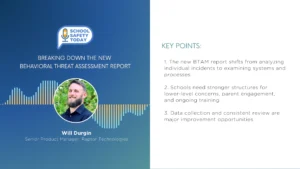School Safety Today: Understanding the Role of Lockdown Drills
Lockdown drills: they may be an increasing trend in education systems across the country, but there is a debate on the merits of these drills versus the impact they have on students, teachers, and staff. Which causes more harm, the threat of a shooting occurring, or the stress imposed by participating in lockdown drills? School Safety Today’s Hilary Kennedy asked two experts to weigh in on the role of lockdown drills and add their insights.
Dr. Jaclyn Schildkraut, an Author, Researcher, and Associate Professor of Criminal Justices at the State University of New York at Oswego, and Dr. Amanda Nickerson, Author, Professor, Psychologist, and Director of the Alberti Center for Bullying Abuse Prevention at the University of Buffalo, presented some of their findings from their comprehensive study on lockdown drills.
“Lockdown drills are a set of procedures that you can use anytime there is a danger inside of a building,” Dr. Schildkraut said. “That can include an active shooter, but that can also include things like an angry parent, or a fight getting out of control, or even a dangerous animal that might find its way into the school building.”
Because lockdown drills are often talked about synonymously with active shooter drills, Dr. Schildkraut said this association could create certain negative connotations and concerns.
There are many arguments both for and against lockdown drills. But Dr. Schildkraut and Dr. Nickerson said their research findings don’t support the opposing views against such exercises. One method Dr. Nickerson said showed promise was to take a trauma-informed approach in such drills
“A trauma-informed approach isn’t necessarily specific to lockdown drills, but it’s something that says that we should actually assume that individuals are more likely rather than less likely to have a history of trauma,” Dr. Nickerson explained. “So, in the procedures that we do in schools and in other organizations, we want to take that into account.”









